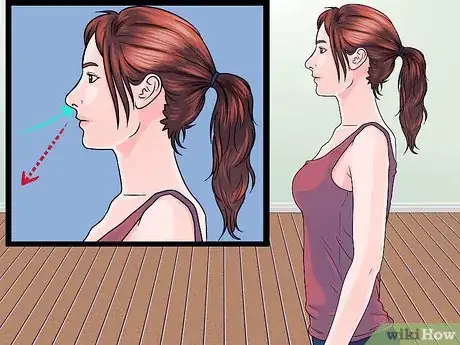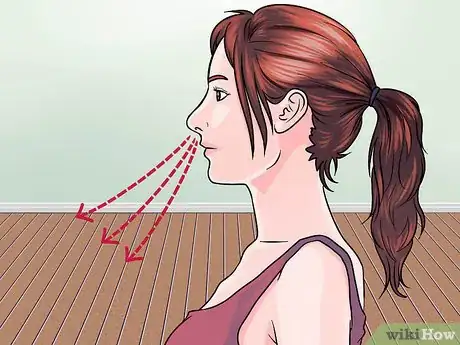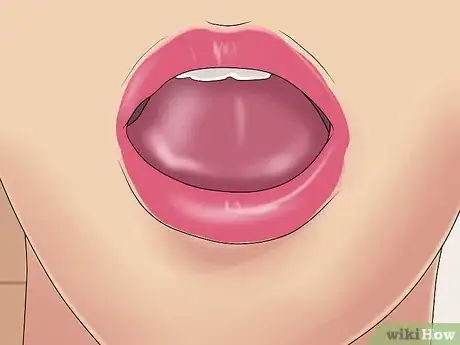This article was co-authored by Annabeth Novitzki. Annabeth Novitzki is a Private Music Teacher in Austin, Texas. She received her BFA in Vocal Performance from Carnegie Mellon University in 2004 and her Master of Music in Vocal Performance from the University of Memphis in 2012. She has been teaching music lessons since 2004.
wikiHow marks an article as reader-approved once it receives enough positive feedback. In this case, 91% of readers who voted found the article helpful, earning it our reader-approved status.
This article has been viewed 130,465 times.
To hold a note, you need to train your breathing and your posture. Standing properly and practicing breathing techniques will train your voice to emerge from you steadily, easily, and at greater and greater lengths.
Steps
Training Your Breath
-
1Breathe in quickly and steadily. Singing uses more breath than speaking, so you might be tempted to gulp your lungs full of air. This is not as helpful as taking steady quick breaths while you sing. Practice drawing in ordinary amounts of air at the beginning of each phrase you sing.
- If you catch yourself gulping or gasping, pause and begin again. Trust your lungs to do their job.
- You will need more air to sing long notes, but you'll get more duration of a slow exhalation than you will out of a deep inhalation.
EXPERT TIPAnnabeth Novitzki is a Private Music Teacher in Austin, Texas. She received her BFA in Vocal Performance from Carnegie Mellon University in 2004 and her Master of Music in Vocal Performance from the University of Memphis in 2012. She has been teaching music lessons since 2004.Music Teacher
 Annabeth Novitzki
Annabeth Novitzki
Music TeacherAnnabeth Novitzki, a private voice teacher, advises: "To hold a note means to sing one note for a long period of time. The most common times when notes are sustained like this is at the ends of phrases, at the end of a song, and at a fermata (a musical symbol indicating to sustain the note longer than usual)."
-
2Exhale slowly. Your breath carries your voice. If you force out air, or try to choke it back, you will not be able to hold long notes. As you sing, notice yourself pushing or halting your exhalation. If you are pushing, you may sound shouty or breathy. Relax your abdominal muscles and try again.
- If you are choking your exhalation, try this exercise: sing a vowel at a pitch in the middle of your range, then gradually shift the note to being a stream of air with no vocalization.
- Once you have mastered moving gradually from a clean tone to a breathy tone to no tone while maintaining pitch, you can try the technique on higher notes.
- Notes that are held are often high, so this is an exceptionally useful exercise.
Advertisement -
3Release more air at the end of a note than at the beginning. Oftentimes, people run out of air while attempting to hold a note because they let a lot of air escape at the beginning of the note. To combat this, intentionally release less air when you first begin to sing a note so that you can release more air as the note comes to an end.[1]
-
4Let no air escape. You need breath to sustain a note. Practice singing without releasing air by listening to your voice. Do you sound breathy? Try to sing the same note again, clearly. Hold a mirror in front of your mouth while you sing the note. The mirror will fog up if you are releasing breath.
- Generally, trying to actively control the flow of your breath will cause you to inadvertently choke or force the air, leading to uneven tone and loss of breath.
- Breathy sounds are sometimes intentional and are often used in specific genres like pop. The breathiness comes from air escaping as your vocal cords vibrate. However, this uses a lot of air and will shorten the length you are able to hold a note.[2]
-
5Hiss. Breathe in, and exhale while saying "SSSS." Release your breath evenly and entirely. Do it again, trying (without pressing or forcing) to say "SSSS" for slightly longer. Don't press or force your "S," but try to release your air evenly and slowly. Incorporate this exercise into your regular warm-up routine.
-
6Lie on your back and breathe. Lie on the floor with your knees up, and inhale and exhale slowly. Feel your back press into the floor. Balance a book on your stomach and exhale. The book should rise: you want to be breathing into your belly, not your chest. This exercise helps you regulate your breathing and can train you to trust your lower back to support your voice.
-
7Use the Farinelli technique. In this technique, breathe in for 3 seconds, hold your breath for 3 seconds, and release your breath for 3 seconds. Your inhalation, hold, and exhalation of breath should be even and should not leave you gasping for air. Once you have completed the cycle smoothly, go immediately into the next cycle, this time breathing, holding, and exhaling for 4 seconds each.
- Do as many cycles as you comfortably can, each time adding a second per stage.
- Stop when you feel abdominal pressure or lightheadedness.
- Six cycles is probably your maximum for your first round, unless you are already a trained vocalist.
- Once you have reached your maximum, repeat the exercise in reverse, subtracting one second per cycle.
- Use a stopwatch or metronome.
- Do this daily, increasing your seconds per cycle, without pausing between cycles.
-
8Sing on a lip trill to transition between breath exercises and song. Singing on a lip trill is a great bridge. It can help you learn to deliver a lot of air without straining your vocal cords. To do a lip trill, gently blow out air from your lips; they will vibrate and make a repeated "br" sound. Then, try to do this while singing a note.
-
9Imagine air spinning out of your mouth. As you sing, picture the breath you exhale spinning quickly out of your mouth. This technique helps to keep your larynx loose and will energize your breath.
Holding A Note With Your Body
-
1Raise your sternum. Raise your arms over your head as you inhale. Keeping your sternum in the same position, lower your arms as you exhale. Another technique is to layer your hands on your lower back, palms outward. Practice the posture of singing with a lifted sternum until it becomes natural.
- Singing with good posture will help you sustain high notes. Your sternum should be raised, and your chest should stay in the same position. Sing in front of a mirror to monitor your posture.
- Avoid letting your ribcage and shoulders collapse as you run out of air; engage your stomach muscles even more at this point. Lift your ribcage and stand up straight to stay in control of your breath.
-
2Engage the muscles that affect your diaphragm. Before you sing, spend a moment flexing and noticing the muscles of your lower abdomen, lumbar spine, and pelvic floor. As you sing, check in again with these muscles, and engage them if they are relaxed. The air flowing through your diaphragm is controlled by these muscles, and engaging them allows you to control the flow of your breath.
- Use your lower abdomen, lumbar spine, and pelvic floor muscles whenever a vocal coach tells you to "use your diaphragm."
- Use this technique rather than that of contracting your abdominal muscles. This will cause uneven pressure and result in injury.
-
3Check for tongue tension. When you sing long notes, which are often high notes, you need your tongue to be relaxed. As you sing, check if your tongue is tense. Push your thumb underneath your chin, which is where the bottom of your tongue is rooted. If you feel tension, massage under your chin while continuing to sing.[3]
- This will help you practice relaxing your tongue as you hold those long high notes.
- Note that the tongue is connected to many small muscles in your neck and throat, so keeping it relaxed is essential for holding long notes and releasing air slowly.
Expert Q&A
Did you know you can get expert answers for this article?
Unlock expert answers by supporting wikiHow
-
QuestionWhat should I do to sing well?
 Annabeth NovitzkiAnnabeth Novitzki is a Private Music Teacher in Austin, Texas. She received her BFA in Vocal Performance from Carnegie Mellon University in 2004 and her Master of Music in Vocal Performance from the University of Memphis in 2012. She has been teaching music lessons since 2004.
Annabeth NovitzkiAnnabeth Novitzki is a Private Music Teacher in Austin, Texas. She received her BFA in Vocal Performance from Carnegie Mellon University in 2004 and her Master of Music in Vocal Performance from the University of Memphis in 2012. She has been teaching music lessons since 2004.
Music Teacher
-
QuestionHow can I sing longer without breathing?
 Annabeth NovitzkiAnnabeth Novitzki is a Private Music Teacher in Austin, Texas. She received her BFA in Vocal Performance from Carnegie Mellon University in 2004 and her Master of Music in Vocal Performance from the University of Memphis in 2012. She has been teaching music lessons since 2004.
Annabeth NovitzkiAnnabeth Novitzki is a Private Music Teacher in Austin, Texas. She received her BFA in Vocal Performance from Carnegie Mellon University in 2004 and her Master of Music in Vocal Performance from the University of Memphis in 2012. She has been teaching music lessons since 2004.
Music Teacher It is impossible to sing without breathing, but you can certainly increase your breath capacity and breath control. One of my favorite exercises is to take a deep breath and exhale as fast as I can through a small coffee straw, using a timer to see how long it takes. When I want to increase my breath control on a certain song, I sing the whole song on lip trill over and over.
It is impossible to sing without breathing, but you can certainly increase your breath capacity and breath control. One of my favorite exercises is to take a deep breath and exhale as fast as I can through a small coffee straw, using a timer to see how long it takes. When I want to increase my breath control on a certain song, I sing the whole song on lip trill over and over. -
QuestionWhat is it called when you hold a note?
 Annabeth NovitzkiAnnabeth Novitzki is a Private Music Teacher in Austin, Texas. She received her BFA in Vocal Performance from Carnegie Mellon University in 2004 and her Master of Music in Vocal Performance from the University of Memphis in 2012. She has been teaching music lessons since 2004.
Annabeth NovitzkiAnnabeth Novitzki is a Private Music Teacher in Austin, Texas. She received her BFA in Vocal Performance from Carnegie Mellon University in 2004 and her Master of Music in Vocal Performance from the University of Memphis in 2012. She has been teaching music lessons since 2004.
Music Teacher
References
About This Article
It can be hard to hold a note while you’re singing, but with the right practice, you can do it. While you’re singing, breathe in quickly and steadily throughout the song. Stand with good posture, and try to push out your voice with your sternum. Intentionally release less air when you first hit the note you want to hold, which will help you save your breath to carry you through the end of the note. As you come to the end, engage your stomach muscles, and avoid letting your ribcage and shoulders collapse as you run out of air. Keep reading for breathing exercises from our reviewer that will help you learn to hold a note!






































































Medical Disclaimer
The content of this article is not intended to be a substitute for professional medical advice, examination, diagnosis, or treatment. You should always contact your doctor or other qualified healthcare professional before starting, changing, or stopping any kind of health treatment.
Read More...